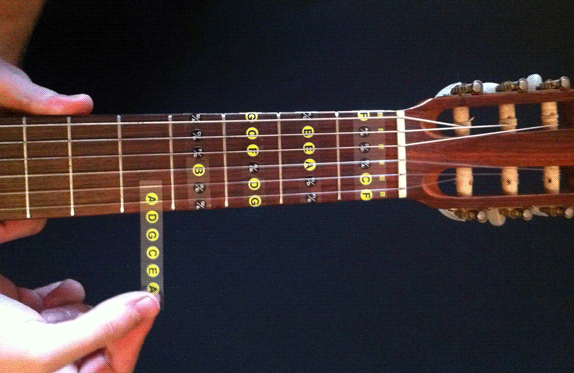How To Play Guitar Notes
Learning the Fretboard
Be sure to check out this new video, which teaches you how to learn the names of the notes:
In order to learn chords, riffs, and songs, you will have to know the names of the notes of the guitar. This is an annoying memorization process that every guitar player must eventually focus on.
The fingerboard of the guitar and the names of the notes of the guitar are not so mysterious, once you learn to recognize the patterns. Essentially, the notes move upward, in alphabetical order until you arrive at G, then they start over again with the letter A.
Easy enough, right? Not so fast. There are a couple wrinkles in this otherwise straight forward pattern. For example, some of the letter notes or 'naturals' as they are sometimes called, have other notes in between them called 'sharps and flats'. For example, the notes named 'A' and 'B' have a note in between them called 'A sharp/B flat'. 'Sharp' basically just means 'one half step higher', and 'flat' basically just means 'one half step lower'. A half step is just one fret. Thus the note 'A sharp' is one fret higher than the note 'A', and the note 'B flat', which is the same note as 'A sharp', is one fret lower than the note 'B'.
All the notes in ascending 'chromatic' order (from lowest notes to highest notes), starting from A and going to G, look like this:
A
A sharp/B flat
B
C
C sharp / D flat
D
D sharp / E flat
E
F
F sharp / G flat
G
G sharp / A flat
And repeat.
Notice that they are in alphabetical order, but some (not all) notes have sharps and flats between them.
Once you know this information, all you need to know in order to figure out every note of the fretboard is the names of the open strings. The string that is closest to your head is called the low E string. It is called the low E string because it is the lowest string and because the note that you play when you play it is an 'E' note. Below are the names of each of the strings:
E - the low E string, also known as the 6th string
A - 5th
D - 4th
G - 3rd
B - 2nd
E - 1st
To have all of this information really sink in, study the two pictures below. One image is that of a guitar, which has the names of the notes printed on stickers placed on the frets. The other is simply a helpful diagram. Read over the information, above, and compare it with what you see in the pictures, below, until it all starts to make sense. If you like, you can purchase stickers similar to those show in the image below from Fret Daddy here. Fret daddy manufacturer removable fret stickers for guitar and bass. Stickers can be an amazing tool for learning guitar.

Fig 1. Downward facing Diagram of notes (body of guitar would be to the right)

Fig 1. Front facing Diagram of notes (body of guitar would be to the left)
It is absolutely critical that you MEMORIZE all of these rules so that you can identify any note at any given time on the fretboard. So do whatever it takes for that to happen. You can print out an image and look at it and study it from time to time, or make flash cards, or purchase the fretboard note map sticker set from Fret Daddy and leave the note names on your guitar until the patterns start to sink in. It's up to you. But you really do need to learn the names. Otherwise, it will be much more difficult to learn chords and impossible to learn theory.

